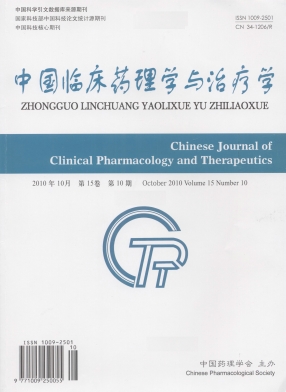Optimized the Dosage Regimen of Piperacillin/Tazobactam in treatment of lower respiratory tract infections based on pharmacokinetics/pharmacodynamics
ZHANG Xiao-Min, HONG Bing, YE Jun-Hui, YE Ai-Ju, YU Xian-Guang, XU Ti, LUO Wu-Jun, FEI Wen-Sheng
2015, 20(6):
677-681.
 Asbtract
(
345 )
Asbtract
(
345 )
 PDF (2295KB)
(
570
)
Related Articles |
Metrics
PDF (2295KB)
(
570
)
Related Articles |
Metrics
Abstract AIM:To evaluate the clinical efficacy and clearance rate of pathogens of piperacillin/tazobactam(PIPC/TAZ),time-dependent antibacterial,acquiring the therapy of extended-infusion and continuous infusion in treatment of patients with lower respiratory tract infection (LRTI), compared with traditional infusion therapy. METHODS:200 inpatients with moderate and severe LRTI in pulmonary department from Jan 2013 to Mar 2014 were randomly divided into experimental group and control group,100 cases each.The cultivated pathogenic bacteria was all susceptible to PIPC/TAZ.A prospective randomized controlled clinical trial was conducted.The patients in experimental group received PIPC/TAZ (3.0/0.75g) every 8h by continuous administration using minip- ump for 3h.By comparison,control group received PIPC/TAZ ( 3.0/0.75g ) every 8h by intravenous drip for 30 minutes.Changes of indexes were observed before and after the treatment,and also compared with the clinical effective rate,clearance rate of pathogens and adverse reaction rate after the treatment.RESULTS:The laboratory parameters in d4 and d8 were counted as follows.Differences between the two groups showed statistical significance(P<0.01) in white cell count, neutrophile granulocyte,C - reactive protein and blood oxygen partial pressure.Compared with the clinical effects in d4 and d8,the total effective rate of experimental group were 78.8% and 90.9% ,which were higher than those in control group(58.6% and 81.8% respectively).There was significant difference between the two groups(P<0.01).Meanwhile,the bacterial clearance rate of the two groups were 91.8% and 78.9%,respectively.The differences were statistically significant(P<0.05). Rates of adverse reactions in experimental group and control group were 2% and 3% respectively,without serious adverse reaction .No obvious statistical difference appeared( P > 0. 05).CONCLUSION:The continuous infusion of PIPC/TAZ by micro-pump for 3h is preferable compared with traditional infusion in treating LRTI,which was more reasonable and effective as time-dependent antibacterial.


